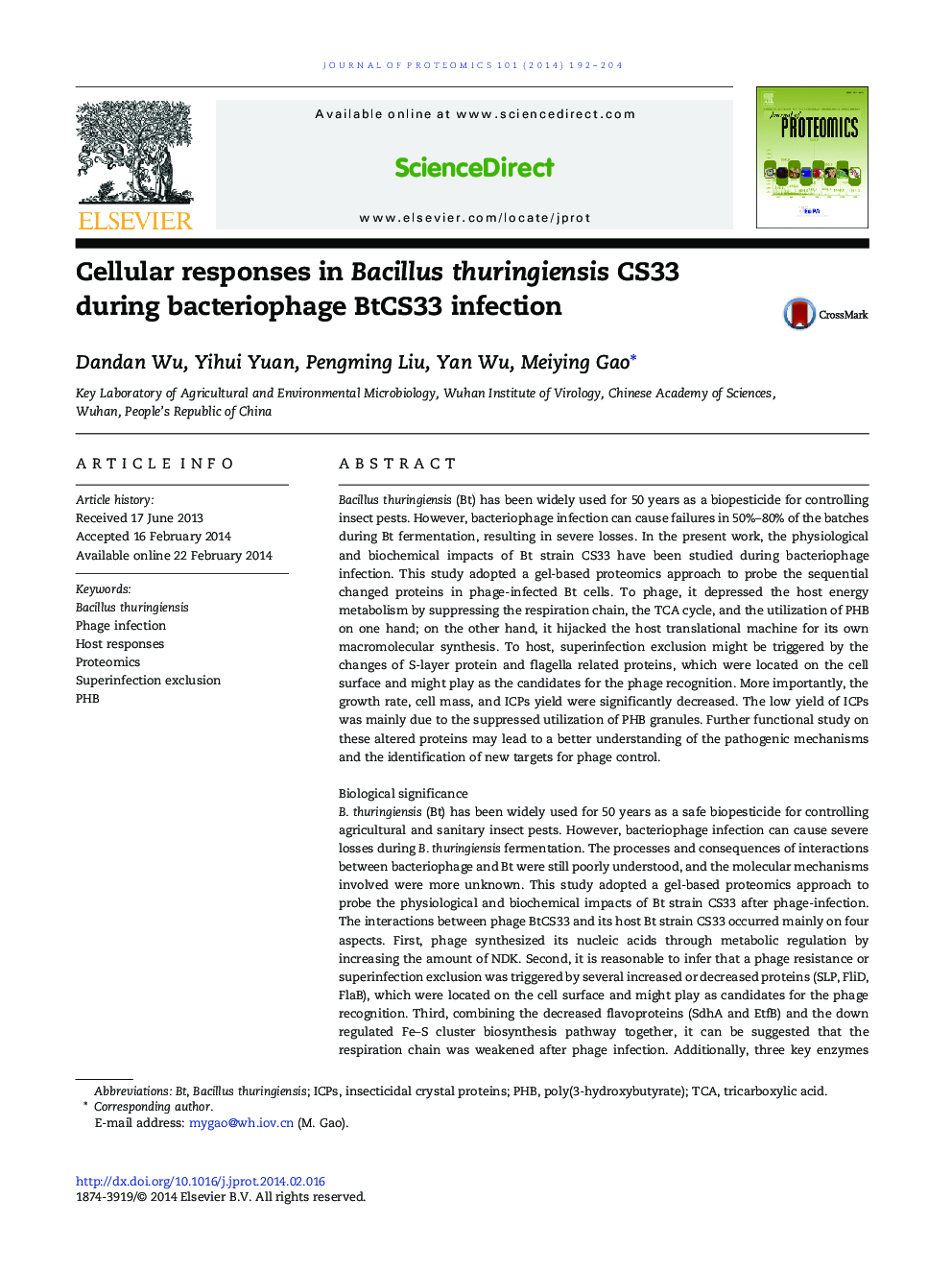| کد مقاله | کد نشریه | سال انتشار | مقاله انگلیسی | نسخه تمام متن |
|---|---|---|---|---|
| 1226010 | 1494779 | 2014 | 13 صفحه PDF | دانلود رایگان |

• We adopted proteomics approach to probe the interactions between phage from Bt and its host.
• Phage synthesized its nucleic acids through metabolic regulation by increasing the amount of NDK.
• Phage depressed the respiration chain and PHB utilization of the host.
• The host triggered superinfection exclusion by the changes of several proteins (SLP, FliD, FlaB).
• The growth rate, cell mass and ICPs yield of the host were significantly decreased.
Bacillus thuringiensis (Bt) has been widely used for 50 years as a biopesticide for controlling insect pests. However, bacteriophage infection can cause failures in 50%–80% of the batches during Bt fermentation, resulting in severe losses. In the present work, the physiological and biochemical impacts of Bt strain CS33 have been studied during bacteriophage infection. This study adopted a gel-based proteomics approach to probe the sequential changed proteins in phage-infected Bt cells. To phage, it depressed the host energy metabolism by suppressing the respiration chain, the TCA cycle, and the utilization of PHB on one hand; on the other hand, it hijacked the host translational machine for its own macromolecular synthesis. To host, superinfection exclusion might be triggered by the changes of S-layer protein and flagella related proteins, which were located on the cell surface and might play as the candidates for the phage recognition. More importantly, the growth rate, cell mass, and ICPs yield were significantly decreased. The low yield of ICPs was mainly due to the suppressed utilization of PHB granules. Further functional study on these altered proteins may lead to a better understanding of the pathogenic mechanisms and the identification of new targets for phage control.Biological significanceB. thuringiensis (Bt) has been widely used for 50 years as a safe biopesticide for controlling agricultural and sanitary insect pests. However, bacteriophage infection can cause severe losses during B. thuringiensis fermentation. The processes and consequences of interactions between bacteriophage and Bt were still poorly understood, and the molecular mechanisms involved were more unknown. This study adopted a gel-based proteomics approach to probe the physiological and biochemical impacts of Bt strain CS33 after phage-infection. The interactions between phage BtCS33 and its host Bt strain CS33 occurred mainly on four aspects. First, phage synthesized its nucleic acids through metabolic regulation by increasing the amount of NDK. Second, it is reasonable to infer that a phage resistance or superinfection exclusion was triggered by several increased or decreased proteins (SLP, FliD, FlaB), which were located on the cell surface and might play as candidates for the phage recognition. Third, combining the decreased flavoproteins (SdhA and EtfB) and the down regulated Fe–S cluster biosynthesis pathway together, it can be suggested that the respiration chain was weakened after phage infection. Additionally, three key enzymes (AcnB, FumC and AdhA) involved in the TCA cycle were all decreased, indicating the TCA cycle was seriously inhibited after infection. Fourth, the growth rate, cell mass and ICPs yield of the host were significantly decreased. To the best of our knowledge, this work represents the first systematic study on the interactions of an insecticidal bacterium with its phage, and has contributed novel information to understand the molecular events in the important biological pesticide producer, B. thuringiensis, in response to phage challenge.
Figure optionsDownload high-quality image (246 K)Download as PowerPoint slide
Journal: Journal of Proteomics - Volume 101, 14 April 2014, Pages 192–204